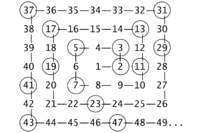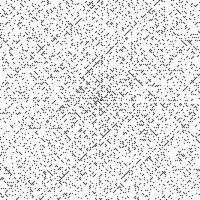Ulam spiral
In mathematics, the Ulam spiral or prime number spiral is a simple way to graphically represent prime numbers . It was discovered in 1963 by the Polish mathematician Stanisław Marcin Ulam during a scientific lecture when, out of boredom, he scribbled rows of numbers on paper. It started with a "1" in the middle and then continued in a spiral shape:
Then he circled all the prime numbers and got the following pattern:

To his surprise, there were a surprising number of prime numbers on diagonal lines, as the graph on the right shows. This is an ulam spiral measuring 200 × 200, with the prime numbers marked by black dots. The diagonal lines are clearly visible. If the distance from the center is sufficiently large, one can also discover horizontal and vertical lines.
It seems like the diagonal lines always appear, regardless of the size of the spiral. This seems to be the case even if the starting number is much larger than 1. It follows that there are many tuples of integers with which the function
- With
results in significantly more prime numbers than would be expected if numbers of the same order of magnitude were chosen at random.
These numbers have long been known to prime number researchers. In the 18th century , the Swiss mathematician Leonhard Euler discovered the formula that resulted in prime numbers for successive values from 0 to 15. In fact, these 16 numbers are the ones that also appear in Ulam's scheme on the main diagonal: 17, 19, 23, 29, 37, 47, 59, 73, 89, 107, 127, 149, 173, 199, 227 and 257. Later Euler found another formula that for revealed from 0 to 40 only primes: . Recalculating on the computer showed that this second Euler's formula was astonishingly good, as it yields prime numbers for up to 10,000,000 in 22.08% of the cases. Ulam found other formulas whose percentages were almost as good at generating prime numbers as those of the Euler formula. However, the pattern of the Ulam spiral cannot be fully explained to this day.
In March 1964, the Ulam spiral was featured on the cover of Scientific American magazine .
literature
- M. Stein, SM Ulam : An Observation on the Distribution of Primes. In: The American Mathematical Monthly. 74, 1967, ISSN 0002-9890 , pp. 43-44.
- ML Stein, SM Ulam, MB Wells: A Visual Display of Some Properties of the Distribution of Primes. In: The American Mathematical Monthly. 71, 1964, pp. 516-520.
- Martin Gardner : Mathematical Recreations: The Remarkable Lore of the Prime Number. In: Scientific American. 210, March 1964, ISSN 0036-8733 , pp. 120-128.
- Paul Hoffman: Erdős. 1913–1996: l'homme qui n'aimait que les nombres. Editions Belin, Paris 2000, ISBN 2-7011-2539-1 .










